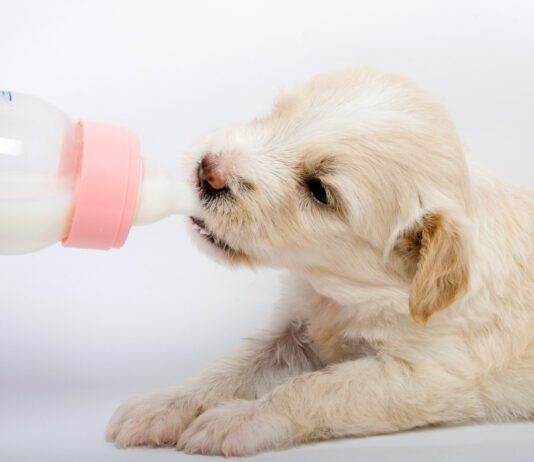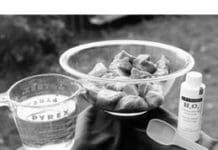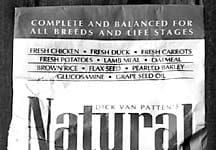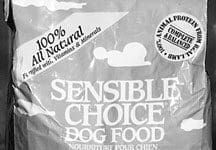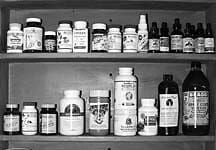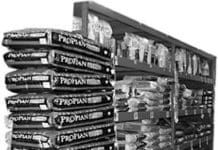When Feeding a Raw Diet Use Safe Meat Handling Practices
One of the greatest concerns many people have about switching their dogs to a raw diet is the fear of bacterial infection, either in themselves or their pets. News reports of people dying from E. coli and salmonella poisoning have no doubt fanned the flames of that fear. But most people who have successfully transitioned their dogs to a raw diet report no problems are delighted with their dogs’ health and appearance. The secret, advocates say, is in good food handling practices. Dog owners who neglect safe handling techniques are certainly more at risk of infection from any pathogens (a list of the usual suspects is discussed in great detail in “What Evil Lurks Within,” page 9) that happen to be present in raw meat. This is especially true of children, whose immune systems are immature and inexperienced, and people with compromised immune systems. But keeping your meat safe and your kitchen clean is not exactly rocket science, folks! Anyone can learn to do it.
Natural Balance Dog Food
We selected Natural Balance as a Top Dry Food in our February 2000 issue, but the food was recently reformulated and bears almost no resemblance to its former self. This incarnation is very impressive. The food now has three major protein sources – chicken (appearing first on the list of ingredients), duck (number third), and lamb meal (fourth), providing a nice complement of amino acids. The makers have also omitted corn, soy, wheat, eggs, white rice, dairy products, and sunflower oil from the food, in an effort to avoid many ingredients that allergic dogs have problems with. Like many companies jumping on the nutraceutical bandwagon, NB has included glucosamine (beneficial for arthritic conditions) and extra vitamin C (for general immune health) in the food. However, without any information as to the amount present in the food, there is no way to say whether the inclusion is at all beneficial.
Raw Food Diet Does the Trick
When Deanna Cuchiaro of Whitehouse Station, New Jersey, set out to adopt an Irish Setter, she had no idea the rescue would change her entire perspective on animal health care. Cuchiaro already had one Irish Setter, Brandy, who had recently turned 10, and she wanted to get another so that Brandy could help pass his positive influence around the house to the newcomer. She considered getting a puppy, but decided to adopt a rescue dog from the Irish Setter Club of Central Connecticut rescue program. She met representatives of the rescue group at a local Irish Setter show who told her there was a large two-year-old male Setter available for adoption.
When it Comes to Dog Food – What Does the Term “Natural” Really Mean?
Maybe it’s partially our fault, but the word “natural” is getting a lot of exposure on dog food labels these days. The problem is, it doesn’t mean anything in particular; there is no official definition of the word. It just sounds good, and companies like Pet Products Plus, Inc., makers of Sensible Choice, like to use it a lot. A bright yellow banner on the front of the bag says, “100% All Natural.” And the back of the label explains, “Sensible Choice dog foods are all-natural products. . . In other words, if it’s not found in nature, you won’t find it in Sensible Choice.” But that just doesn’t explain something like “natural flavor,” the sixth ingredient listed on the label of the Sensible Choice Lamb and Rice food. Natural what flavor?
Can Meat Cause Kidney Failure?
CA 94501; or fax to (510) 749-4905
Information on Our Dog Food Reviews
We’ve had a LOT of mail, email, and phone calls since we published our dry dog food review last month, mostly from people who wanted more information. We are thrilled that people are finally learning to be concerned with the food their dogs eat. We’re also pleased that a large percentage (perhaps a full three-quarters) of the people who contacted us asked, “What about the three foods that were on your list last year (Beowulf’s Back to Basics, Solid Gold’s Hund ‘N Flocken, and Wysong) that weren’t on your list this year?” What loyal readers! You guys are all over it! To answer the question for all three foods: They still meet all our criteria; they are still good foods. We like them! We like them! We really like them!
Choosing Canine Supplements Wisely
Sometimes, the deficiency is discovered when a blood test is performed for the purpose of analyzing the dog’s nutritional status (although, in my opinion, there are some problems with this methodology (see “Blood Testing for Deficiencies,” next page). In other cases, a dog owner might know that the diet he feeds is deficient in a certain nutrient, and he supplements rather than changes the formulation of the diet. For example, dogs who are fed a diet based on raw meats and vegetables, but who don’t receive fresh ground bones, are more than likely to be deficient in calcium.
What’s On The Label?
Thank you for mentioning our product, Home Made 4 Life (“Food in the Freezer,” March 2000). Some important information was not mentioned in your article! We feel these key points set our companies and our product apart from our competition: Home Made 4 Life pet food is formulated by professional animal nutritionists Jennifer Boniface, MS, and Trina Nowak, BScAgr, each of whom hold higher education degrees in animal nutrition. Home Made 4 Life is the only international pet food of its type, with manufacturing taking place both in Maryland (Aunt Jeni’s Home Made) and Ontario, Canada (Pets 4 Life).
Whole Dog Journal’s 2000 Canned Dog Food Review
these days?) and they can't share the information with you for fear that the knowledge will spread and this will result in some sort of advantage by their competitors.
The truth is
Labeling Dog Food Just Like People Food!
We’ve been whining lately about the dog food industry’s reluctance to embrace and use a “date of manufacture” on their product labels. There is no argument that fresher foods are better foods; with time, vitamins degrade, oils go stale and become rancid, and molds may develop, no matter what sort of preservatives are used. But the big pet food makers would rather concentrate on making their foods last as long as possible – extending shelf life with preservatives, keeping oxygen out of the food with cutting-edge technology bags, etc. – than working out a distribution system that gets their products into the bowls of consumers faster.
Who’s in Charge of Pet Food Manufacturing Regulations?
While most dog owners are certain that “someone” is in charge of regulating the manufacture of commercial dog food in this country, very few people know who that mysterious official or agency might be. But somebody’s gotta be making sure that dog food doesn’t contain any harmful ingredients and does contain what dogs need to survive, right? The FDA? Department of Agriculture? Someone?
Does Your Dog Eat Grass?
radish sprouts


